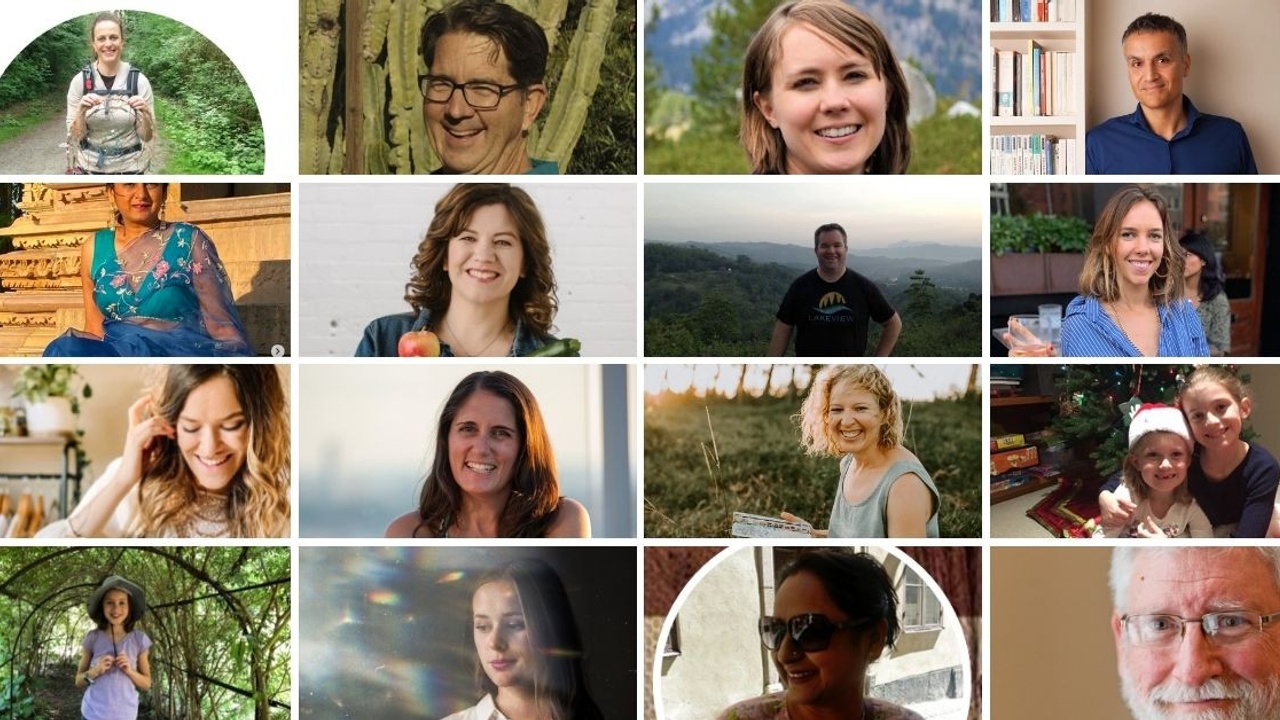Sustainable wellbeing and green living
Let's find ways to Flourish!
#EarthOptimism

If you’ve noticed that mainstream environmental news tends to be increasingly negative and concerning, you’re not alone. And to be fair, there are lots of environmental issues to be concerned about – so it’s natural that these issues, such as forest fires, floods, and increasing carbon dioxide levels in the atmosphere, are being reported on.
It is true that this type of environmental reporting can be effective. Especially for those who may be unaware of how serious the issue of climate change is. But for the rest of us who are aware of these issues and are taking steps to live more sustainably, being constantly bombarded with negative news can be exhausting, and even depressing.
In fact, it might even be increasing your eco-anxiety. Eco-anxiety is often defined as a chronic fear of environmental doom which stems out of a place of deep caring for the planet and its inhabitants. To learn more about eco-anxiety, check out episode 5 from my Live.Well.Green Podcast “Strategies for Combatt...
Environmental Justice goes beyond Climate Justice

Environmental justice is a social movement that acknowledges the disproportionate burden of environmental damage, loss of land, poor living and working conditions and risk placed on people of colour, the global south, low-income countries, Indigenous peoples around the world, and marginalized groups.
The modern environmental justice movement emerged in the United States in the early 1980s, and calls for the fair distribution of environmental benefits and burdens across all communities, regardless of socioeconomic status and seeks to address environmental discrimination.
Environmental justice will be achieved when everyone can enjoy equal degrees of protection from environmental and health hazards as well as access to meaningful involvement in the environmental decision-making process. Environmental issues must be discussed within the context of racism.
Environmental discrimination and racism affect predominantly Black and Indigenous communities across North America. The U.S. Environ...
What simple trick reduces air pollution and saves money? Idle-Free Zones

Most people are aware of the fact that vehicles have a negative impact on the environment through their use of fossil fuels. Fossil fuels release harmful pollutants such as carbon dioxide into the atmosphere, effectively contributing to global warming. However, what you might not know is that vehicles produce 12% more emissions when idling than they do while driving.
What exactly is idling? Idling is running your engine while your car isn’t moving. If you are a vehicle owner, then there is a good chance you have been guilty of this practice. After all, driving isn’t always an efficient method of transportation. You might often find yourself hitting every red light or getting stuck in traffic.
In fact, there are many reasons why drivers idle.
Why we idle vehicles
One of the main reasons why drivers idle has to do with weather conditions. If you live in a location that suffers from very cold winters or scorching hot summers, you’ll be familiar with the practice of warming up or cooli...
The importance of small wins in the action pyramid

Don't get me wrong, I love well-integrated initiatives that create lasting change, but what I see ALL THE TIME are people struggling with knowing what action to take - and that leads to inaction, or too many projects started and nothing finished. Without finishing and realizing the end goal, we deprive ourselves and the world of the benefits of these initiatives.
A time and a place
So, there is a time and a place for well-defined, small concise projects that realize their modest little goals - and get the win! These small wins are actually vital in realizing larger goals. They provide us with momentum, and a sense of accomplishment, individually and collectively. And they can be really useful as demonstration projects that set us up for success when it comes to larger projects.
I like to think of these small wins as being the base of the Action Pyramid. They are at the bottom because there are lots of them, they are easy to achieve, accessible, and they save money and even time and ...
One Year of Sustainable Wellbeing Activities

Sustainable wellbeing is the intersection of personal wellbeing with social and environmental sustainability. By pursuing sustainable wellbeing, we can feel good about ourselves while taking care of the planet and community we live in!
While finding sustainable wellbeing is our goal, it might seem easier said than done. You might find yourself wondering “what exactly does sustainable wellbeing look like?” or “what concrete steps can I take to achieve sustainable wellbeing?”
Well, there isn’t one path towards sustainable wellbeing. The truth is that sustainable wellbeing looks different for everyone. The steps you take to improve your mental, physical, and spiritual wellbeing are likely to be determined by your own lifestyle, values, personality and more.
That being said, it certainly can be difficult to forge your own path at times. If you struggle with thinking of ways to achieve sustainable wellbeing, you’re not alone! Staying inspired isn’t always an easy task – which is why I ha...
Collaborate with Nature through Land Art

“Art is born of the observation and investigation of nature” – Cicero
The environmental art movement emerged in the 1960s and 1970s alongside increasing citizen awareness of environmental issues as well as the human impact on the environment.
During these times, many artists were looking for ways to showcase the human connection to the natural world. There are a variety of reasons why artists choose to engage in land art such as the desire to draw attention to environmental issues, work in harmony with nature, or challenge the traditional concept of art production.
What is land art?
Although art has depicted natural scenes for centuries, land art is unique in the way that the art piece is nature itself.
Unlike traditional art pieces which utilize paints, varnishes, metals, plastics, and other man-made materials that have the potential to harm the environment and human health, land art does not have a negative environmental impact.
Land art uses materials that are found in the nat...
Activism 101

"You must unite behind the science. You must take action. You must do the impossible. Because giving up can never ever be an option." – Greta Thunberg
Raising awareness about environmental issues is essential when it comes to creating change and protecting the environment. Yes, your personal act matters, but you can amplify your impact by making others aware of your actions and desire for social change.
Without the voices and actions of activists, many environmental issues would go unchecked and cause further degradation. We are in the midst of a critical paradigm shift as I see it. There is an increasing awareness of the issues, demand for a different pathway, and adding your voice can make all the difference!
Education as Activism
Researching an environmental issue will provide you with essential information such as why the issue is occurring, where it is most prevalent, what actions contribute to the issue, how it can be prevented/reduced, and what efforts are currently bein...
From the Flourishing Community

In honour of the 100th edition of the Flourishing Fridays newsletter, I thought it would be great to profile some of the amazing work that folks in this community are doing. Sharing some inspiration and celebrating our wins, big and small. Together we are learning about how to live more sustainably, how to spread the ideas of green living and to enjoy life more!
What an amazing and inspiring list!
Aditya is helping to educate others about the importance of protecting wilderness.
AJ fixes appliances, builds with reclaimed lumber, raises bees and enjoys time in nature.
AK – promotes thrifted fashion for badass Millennials on her social media accounts.
Angelika got small recycling bins for her condo complex and avoids wasting food.
Anuradha – runs sustainable clothing companies using all traditional textiles and zero waste production that also provides employment for women in India.
Amanda is eating more local food and loves to support local businesses.
Anders helps kids in low-in...
Using nature to manage human wastes

So what exactly happens to the human waste that is flushed down our toilets every day? Well, for most of us, it goes to a wastewater treatment plant (unless you live in a city that still dumps human waste directly into the ocean - let’s hope not!)
These Wastewater treatment plants tend to be very large, very smelly buildings (yes, I have toured them with my students). Where garbage is removed, solids are settled out and oil is skimmed off and microbes get to work at breaking down the organics and nutrients until the liquid is clean enough to be sent back into a nearby river or lake or the ocean.
However, there are viable alternatives that actually mimic nature and do the same job - while also creating other benefits.
Water of Life
Water is one of our most valuable natural resources. In fact, a person can live for up to one month without food but only about one week without water. However, freshwater is not always easily accessible. While nearly 70 percent of the world is covered by...
Remember the ozone hole?

It is no secret that on a global scale, the world is suffering from issues such as climate change and its related processes, poverty, pollution, malnourishment and hunger, and lack of security and wellbeing. While it can be depressing to think about all these current global problems, I think it is really important to remember that we have actually succeeded on a number of similarly pressing issues.
Do you remember hearing about the “hole in the ozone”? Well, it is actually something that gives me a lot of hope! That’s because it was a global problem of pollution that crossed borders and affected human health, agriculture and ecosystems. Yes, sounds familiar right? But guess what we got together and are on track to have that problem solved in the next 30 years! Yes, I said SOLVED!
Doing it together makes it work
With these global, large-scale problems, we need countries around the world to work together on the same goals and targets in concert on these issues. While individual nation...

